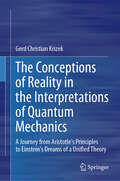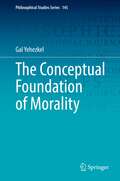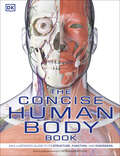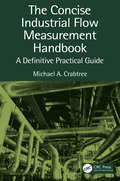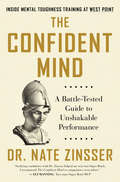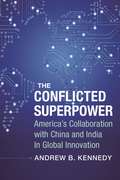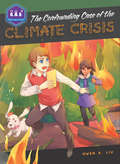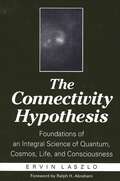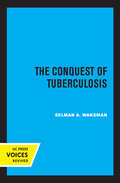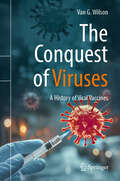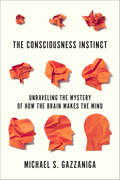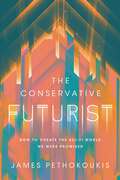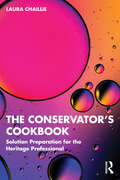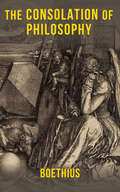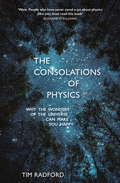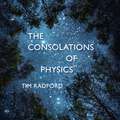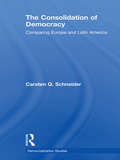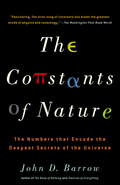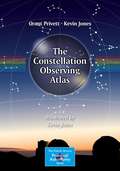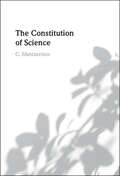- Table View
- List View
The Concept of Time in Early Twentieth-Century Philosophy
by Flavia SantoianniThis book presents a collection of authoritative contributions on the concept of time in early twentieth-century philosophy. It is structured in the form of a thematic atlas: each section is accompanied by relevant elementary logic maps that reproduce in a "spatial" form the directionalities (arguments and/or discourses) reported on in the text. The book is divided into three main sections, the first of which covers phenomenology and the perception of time by analyzing the works of Bergson, Husserl, Sartre, Merleau-Ponty, Deleuze, Guattari and Derrida. The second section focuses on the language and conceptualization of time, examining the works of Cassirer, Wittgenstein, Heidegger, Lacan, Ricoeur and Foucault, while the last section addresses the science and logic of time as they appear in the works of Guillaume, Einstein, Reichenbach, Prigogine and Barbour. The purpose of the book is threefold: to provide readers with a comprehensive overview of the concept of time in early twentieth-century philosophy; to show how conceptual reasoning can be supported by accompanying linguistic and spatial representations; and to stimulate novel research in the humanistic field concerning the complex role of graphic representations in the comprehension of concepts.
The Conceptions of Reality in the Interpretations of Quantum Mechanics: A Journey from Aristotle’s Principles to Einstein’s Dreams of a Unified Theory
by Gerd Christian KrizekThis book explores the different conceptions of reality in the various interpretations of Quantum Mechanics, demonstrating the intimate connection to philosophy of physics. With interest in the foundations of Quantum Mechanics having revived in recent decades, a number of interpretations have been formulated or rediscovered and these remain in strong competition with one another for acceptance by the scientific community. At the same time they imply quite different notions of reality. The author provides an overview of these conceptions of reality and their embedding in physical theories, interpretations of Quantum Mechanics and related philosophical frameworks. Starting with Aristotle’s principles, the deep fruitful connection between philosophy and physics guides this journey through the foundations of Quantum Mechanics.
The Conceptual Foundation of Morality (Philosophical Studies Series #145)
by Gal YehezkelThis book offers a solution to the ancient philosophical problem regarding the nature and the justification of morality. The importance of this subject matter is obvious, not merely as an abstract philosophical problem, but perhaps even more as a practical challenge, regarding the way we ought to live our lives: the values that ought to direct us, and the ends that we ought to pursue.In the course of this inquiry, a wide array of philosophical topics is explored: the nature of intentional action, and the role played by reason and desires in agency; the question of the final end of agency – better known in ancient terminology as the question of the purpose of life, and in modern terms as the question of the meaning of life; the nature of moral obligations and their rational justification; the challenge posed by determinism for the freedom of the will, with its implications on fatalism and moral responsibility; and normative questions regarding the value of life. This book is of interest not only to professional philosophers, but also to any intellectual who is concerned with questions about morality, our nature as agents, and the end that we ought to pursue.
The Concise Human Body Book (DK Human Body Guides)
by DKDiscover all there is to know about human anatomy in DK's latest concise visual guide to the human body.Fully updated to reflect the latest medical information, The Concise Human Body Book is illustrated throughout with colorful and comprehensive diagrams, photographs, scans, and 3D artworks, which take you right into the cells and fibers that are responsible for keeping your body ticking.The Concise Human Body Book provides full coverage of the body, function by function, system by system. In the opening chapter, colorful medical scans, illustrations, and easy-to-understand diagrams show you how the different parts of the body work together to produce a living whole. Eleven main body systems - including the skeletal system, cardiovascular system, and respiratory system - are then covered in intricate detail in the following chapters, with each section ending on common diseases and disorders that can affect that system.From bones and muscles to systems and processes, this in-depth, pocket-sized guide to the body's physical structure, chemical workings, and potential problems is the must-have reference manual for trainee medical professionals, students, or anyone interested in finding out more about how the human body works.
The Concise Industrial Flow Measurement Handbook: A Definitive Practical Guide
by Michael A. CrabtreeThe Concise Industrial Flow Measurement Handbook: A Definitive Practical Guide covers the complete range of modern flow measuring technologies and represents 40 years of experiential knowledge within a wide variety of industries, and from more than 5000 technicians and engineers who have attended the author’s workshops. This book covers all the current technologies in flow measurement, including high accuracy Coriolis, ultrasonic custody transfer, and high accuracy magnetic flowmeters. The book also discusses flow proving and limitations of different proving methods. This volume contains over 300 explanatory drawings and graphs and is presented in a form suitable for both the beginner, with no prior knowledge of the subject, as well as the more advanced specialist. This book is aimed at professionals in the field, including chemical engineers, process engineers, instrumentation and control engineers, and mechanical engineers.
The Concise Manual of Apheresis Therapy
by Eisei Noiri Norio HanafusaThis pocket-sized manual serves as a concise and ideal reference work for therapeutic approaches using apheresis, Covering both basic theory and clinical details to facilitate improved treatment and patient outcomes, the text considers a variety of diseases, including myasthenia gravis, multiple sclerosis, Guillain-Barre syndrome, chronic inflammatory demyelinating polyneuropathy, nephrotic syndrome, TTP/TMA, dilated cardiomyopathy, and many other conditions. The books also reviews the growing trend towards adopting this unique therapy for a wide range of health management issues such as morbid obesity and/or type 2 diabetes, and for lowering LDL-cholesterol (cholesterol apheresis) in patients unresponsive to medication or lifestyle modification.
The Concise Oxford Dictionary of Archaeology
by Timothy DarvillDarvill (archaeology, Bournemouth U., UK) presents an introduction and reference to archaeology as a science, offering some 4,000 entries addressing themes, trends, techniques, major figures, legislation, and important discoveries and findings around the world. Annotation c. Book News, Inc., Portland, OR (booknews.com)
The Confident Mind: A Battle-Tested Guide to Unshakable Performance
by Dr. Nate ZinsserBelieve and be unshakable.The Director of West Point’s influential Performance Psychology Program shares the secrets of mental toughness and self-belief in this definitive guide to mastering confidence, the key to performance in any field.Dr. Nate Zinsser has spent his career training the minds of the U.S. Military Academy’s cadets as they prepare to lead and perform when the stakes are the very highest—on the battlefield. Alongside this work, he has coached world-class athletes including a Super Bowl MVP, numerous Olympic medalists, professional ballerinas, NHL All-Stars, and college All-Americans, teaching them to overcome pressure and succeed on the biggest stages.Dr. Zinsser has come to understand that one single trait above all others makes peak performance possible: confidence, or the belief in oneself. Whether your mission involves leading a platoon into combat, returning an opponent’s serve, or delivering a sales pitch to a roomful of skeptical prospects, you perform best when you are so certain about your abilities that your flow of fear, doubts, and confusion slows to the barest minimum. What’s more, Dr. Zinsser has come to understand that confidence is a skill that can be taught, improved, and applied by anyone to enhance nearly every aspect of our lives and careers.Now, for the first time, Dr. Zinsser distills his research and years of experience, offering a fascinating guide to the science of confidence and providing readers with a practical, step-by-step program to best harness their belief in themselves to achieve success in any field. The Confident Mind is a complete guide to confidence: how to understand it, how to build it, how to protect it, and how to rely upon it when your performance matters most.
The Conflicted Superpower: America’s Collaboration with China and India in Global Innovation (A Nancy Bernkopf Tucker and Warren I. Cohen Book on American–East Asian Relations)
by Andrew KennedyFor decades, leadership in technological innovation has sustained U.S. power worldwide. Today, however, processes that undergird innovation increasingly transcend national borders. Cross-border flows of brainpower have reached unprecedented heights, while multinationals invest more and more in high-tech facilities abroad. In this new world, U.S. technological leadership increasingly involves collaboration with other countries. China and India have emerged as particularly prominent partners, most notably as suppliers of intellectual talent to the United States. In The Conflicted Superpower, Andrew Kennedy explores how the world’s most powerful country approaches its growing collaboration with these two rising powers.Whereas China and India have embraced global innovation, policy in the United States is conflicted. Kennedy explains why, through in-depth case studies of U.S. policies toward skilled immigration, foreign students, and offshoring. These make clear that U.S. policy is more erratic than strategic, the outcome of domestic battles between competing interests. Pressing for openness is the “high-tech community”—the technology firms and research universities that embody U.S. technological leadership. Yet these pro-globalization forces can face resistance from a range of other interests, including labor and anti-immigration groups, and the nature of this resistance powerfully shapes just how open national policy is. Kennedy concludes by asking whether U.S. policies are accelerating or slowing American decline, and considering the prospects for U.S. policy making in years to come.
The Confounding Case of Climate Crisis
by Owen R. Liu Barbara TinkerWith time travel and mysteries that need solving, the Galactic Academy of Science (G.A.S.) series instructs readers on how to think like scientists. Under the guidance of a Dude or Dudette from the future, the middle school characters are faced with treacherous, present-day crimes that require a historical knowledge of science in order to be solved. From investigating problems to analyzing data and constructing explanations and solutions, this series blends elements of sci-fi with educational methods that distill the key thinking habits of scientists and engineers. An adventure that investigates the causes and consequences of climate change Something strange is going on during Anita and Benson's field trip to a greenhouse as their guide is making wild claims about carbon dioxide and their science teacher, Mr. Fazmel, has mysteriously disappeared. That's when Quarkum Phonon, a Dude from the future, sends Anita and Benson on a Galactic Academy of Science mission to learn about the origins of climate change and the ways communities around the world are dealing with its impact. With stops around the world--from a Hawaiian volcano to Greenland and Geneva--Anita and Benson sift through the evidence for climate change. On their return home, the students face the question: what can a couple of kids do to reduce CO2 emissions and slow down climate change? A portion of all profits from this book will go to support local projects helping people in the developing world adapt to climate change.
The Connections Between Ecology and Infectious Disease (Advances in Environmental Microbiology #5)
by Christon J. HurstThis book summarizes current advances in our understanding of how infectious disease represents an ecological interaction between a pathogenic microorganism and the host species in which that microbe causes illness. The contributing authors explain that pathogenic microorganisms often also have broader ecological connections, which can include a natural environmental presence; possible transmission by vehicles such as air, water, and food; and interactions with other host species, including vectors for which the microbe either may or may not be pathogenic. This field of science has been dubbed disease ecology, and the chapters that examine it have been grouped into three sections. The first section introduces both the role of biological community interactions and the impact of biodiversity on infectious disease. In turn, the second section considers those diseases directly affecting humans, with a focus on waterborne and foodborne illnesses, while also examining the critical aspect of microbial biofilms. Lastly, the third section presents the ecology of infectious diseases from the perspective of their impact on mammalian livestock and wildlife as well as on humans. Given its breadth of coverage, the volume offers a valuable resource for microbial ecologists and biomedical scientists alike.
The Connectivity Hypothesis: Foundations of an Integral Science of Quantum, Cosmos, Life, and Consciousness
by Ervin LaszloErvin Laszlo, widely regarded as the founder of systems philosophy and general evolution theory, introduces the foundations of a genuine unified theory of the world in this pioneering treatise on the new sciences. In contrast to other unified theories that center mainly on physics, Laszlo's embraces quantum, cosmos, life, as well as consciousness. He delineates the principles of a new physics of universal connectivity and puts forth the corresponding metaphysics, discussing the implications for such philosophical issues as the nature of matter and mind, freedom and morality, and design versus evolution. This landmark book lays the groundwork for the non-materialist and non-reductionist yet rigorous paradigm that is likely to signal the next revolution in science: the "paradigm of universal connectivity."
The Conquest of Tuberculosis
by Selman A. WaksmanThis title is part of UC Press's Voices Revived program, which commemorates University of California Press’s mission to seek out and cultivate the brightest minds and give them voice, reach, and impact. Drawing on a backlist dating to 1893, Voices Revived makes high-quality, peer-reviewed scholarship accessible once again using print-on-demand technology. This title was originally published in 1964.
The Conquest of Viruses: A History of Viral Vaccines
by Van G. WilsonThis book guides through the fascinating history of viral vaccines, from the first primitive smallpox vaccination in the 18th century to the cutting-edge RSV formulation approved in 2023. Each chapter delves into the scientific, clinical, and social forces that led to the development of these life-saving medical innovations, highlighting the scientists who played pivotal roles. With a focus on making complex science accessible and history engaging, this book offers a comprehensive portrayal of virology, vaccinology and the interplay between science and society in shaping public health. Readers will explore key concepts such as the evolution of vaccine technology over time, from cowpox material to mRNA vaccines, and a wide array of other topics, including the eradication of diseases through vaccines, the challenges of immunization against influenza, and the revolutionary impact of COVID-19 vaccination. The author, microbiologist Professor Wilson, provides expert analysis on how sociological factors influenced vaccine progress and gets to the bottom of the question of why there is still no vaccine for some critical diseases. This book is a must-read for anyone with an interest in viruses and vaccines. Whether you're a researcher or simply fascinated by medical history, this book promises to be both informative and entertaining.
The Consciousness Instinct: Unraveling the Mystery of How the Brain Makes the Mind
by Michael S. Gazzaniga“The father of cognitive neuroscience” illuminates the past, present, and future of the mind-brain problemHow do neurons turn into minds? How does physical “stuff”—atoms, molecules, chemicals, and cells—create the vivid and various worlds inside our heads? The problem of consciousness has gnawed at us for millennia. In the last century there have been massive breakthroughs that have rewritten the science of the brain, and yet the puzzles faced by the ancient Greeks are still present. In The Consciousness Instinct, the neuroscience pioneer Michael S. Gazzaniga puts the latest research in conversation with the history of human thinking about the mind, giving a big-picture view of what science has revealed about consciousness.The idea of the brain as a machine, first proposed centuries ago, has led to assumptions about the relationship between mind and brain that dog scientists and philosophers to this day. Gazzaniga asserts that this model has it backward—brains make machines, but they cannot be reduced to one. New research suggests the brain is actually a confederation of independent modules working together. Understanding how consciousness could emanate from such an organization will help define the future of brain science and artificial intelligence, and close the gap between brain and mind.Captivating and accessible, with insights drawn from a lifetime at the forefront of the field, The Consciousness Instinct sets the course for the neuroscience of tomorrow.
The Conservative Futurist: How to Create the Sci-Fi World We Were Promised
by James PethokoukisDiscover the surprising case for how conservatism can help us achieve the epic sci-fi future we were promised. America was once the world&’s dream factory. We turned imagination into reality, from curing polio to landing on the Moon to creating the internet. And we were confident that more wonders lay just over the horizon: clean and infinite energy, a cure for cancer, computers and robots as humanity&’s great helpers, and space colonies. (Also, of course, flying cars.) Science fiction, from The Jetsons to Star Trek, would become fact. But as we moved into the late 20th century, we grew cautious, even cynical, about what the future held and our ability to shape it. Too many of us saw only the threats from rapid change. The year 2023 marks the 50th anniversary of the start of the Great Downshift in technological progress and economic growth, followed by decades of economic stagnation, downsized dreams, and a popular culture fixated on catastrophe: AI that will take all our jobs if it doesn&’t kill us first, nuclear war, climate chaos, plague and the zombie apocalypse. We are now at risk of another half-century of making the same mistakes and pushing a pro-progress future into the realm of impossibility. But American Enterprise Institute (AEI) economic policy expert and long-time CNBC contributor James Pethokoukis argues that there&’s still hope. We can absolutely turn things around—if we the people choose to dream and act. How dare we delay or fail to deliver for ourselves and our children. With groundbreaking ideas and sharp analysis, Pethokoukis provides a detailed roadmap to a fantastic future filled with incredible progress and prosperity that is both optimistic and realistic. Through an exploration of culture, economics, and history, The Conservative Futurist tells the fascinating story of what went wrong in the past and what we need to do today to finally get it right. Using the latest economic research and policy analysis, as well as insights from top economists, historians, and technologists, Pethokoukis reveals that the failed futuristic visions of the past were totally possible. And they still are. If America is to fully recover from the COVID-19 pandemic, take full advantage of emerging tech from generative AI to CRISPR to reusable rockets, and launch itself into a shining tomorrow, it must again become a fully risk-taking, future-oriented society. It&’s time for America to embrace the future confidently, act boldly, and take that giant leap forward.
The Conservator's Cookbook: Solution Preparation for the Heritage Professional
by Laura ChaillieThe Conservator’s Cookbook is a collection of practical, step-by-step guides outlining how to prepare various solutions, adhesives, gels, and other mixtures used in heritage conservation.While most conservators learn the chemical rationale of solution-making during their training, the actual process of preparing these compounds can be neglected or eventually forgotten. This “cookbook” provides a non-exhaustive and adaptable resource, compiling practical recipes from across heritage conservation literature into a single volume. Drawing from techniques used in furniture, paper, paintings, textiles, and other conservation specialisms, each “recipe” in the Cookbook begins with a short summary of key chemical ideas, before relating step-by-step instructions. The solutions range from simple dissolutions (adhesive resins), to more complex cleaning systems (utilising surfactants, chelation agents, and enzymes) and gelled carriers. Each “recipe” is followed with collections of technical data which help to bridge the gap between chemical understanding and practical application. The Cookbook also provides important notes on health and safety and laboratory best practice, addressing some common misunderstandings and encouraging more sustainable approaches. Intended for the experienced professional and conservation student alike, The Conservator’s Cookbook is a crucial reference work that provides a starting point for practical experimentation and interaction between different conservation specialisms.
The Consolation of Philosophy
by BoethiusOften described as the last great work of Western classical antiquity, Boethius' Consolation of Philosophy grapples with many of the enduring questions in philosophy; the problem of evil, determinism vs. free-will and nature of virtue and justice, among others. Though a committed Christian, Boethius arrives at his conclusions by means of the natural philosophical methods of Classical Greece alone, being of the opinion that faith and reason must necessarily arrive at the same conclusions.
The Consolations of Physics: Why the Wonders of the Universe Can Make You Happy
by Tim Radford'A beautifully crafted love letter to physics.' Nature'A book more about life and passion than physics. People who have never cared a jot about physics (like me) must read this book.' SUZANNE O'SULLIVANThe Consolations of Physics is an eloquent manifesto for physics. In an age where uncertainty and division is rife, Tim Radford, science editor of the Guardian for twenty-five years, turns to the wonders of the universe for consolation. 'A beautiful, inspiring reflection on science, humanity, space, and matter.' SARAH BAKEWELLFrom the launch of the Voyager spacecraft and how it furthered our understanding of planets, stars and galaxies to the planet composed entirely of diamond and graphite and the sound of a blacksmith's anvil; from the hole NASA drilled in the heavens to the discovery of the Higgs Boson and the endeavours to prove the Big Bang, The Consolations of Physics will guide you from a tiny particle to the marvels of outer space.
The Consolations of Physics: Why the Wonders of the Universe Can Make You Happy
by Tim RadfordThe Consolations of Physics is an eloquent manifesto for physics. In an age where uncertainty and division is rife, Tim Radford, science editor of the Guardian for twenty-five years, turns to the wonders of the universe for consolation. From the launch of the Voyager spacecraft and how it furthered our understanding of planets, stars and galaxies to the planet composed entirely of diamond and graphite and the sound of a blacksmith's anvil; from the hole NASA drilled in the heavens to the discovery of the Higgs Boson and the endeavours to prove the Big Bang, The Consolations of Physics will guide you from a tiny particle to the marvels of outer space.
The Consolidation of Democracy: Comparing Europe and Latin America (Democratization Studies)
by Carsten Q. SchneiderThis book investigates the successes and failures in consolidating those democratic regimes that emerged in Europe and Latin America in the last quarter of the 20th century. The theoretical approach developed combines the most prominent political-institutional and socio-structural approaches to explaining the Consolidation of Democracy (CoD). Reinterpreting conventional claims, Schneider’s comparative analyses of 32 countries indicates that the driving force behind CoD is the fit between the institutional type of democracy and the societal context in terms of power dispersion. This book: presents new data measuring dimensions of regime transition processes in Latin America, the Middle East and Northern Africa, as well as some former Soviet republics; reassesses some core assumptions of the dominant transition paradigm; discusses general methodological issues involved when investigating causally complex claims in comparative social research and presents fuzzy set Qualitative Comparative Analysis (fsQCA) as a valuable addition to the methodological tool kit of comparative social scientists. This innovative and important volume will be of interest to political scientists, particularly those with an interest in democracy, democratization, comparative politics and comparative methodology.
The Constants of Nature: The Numbers That Encode the Deepest Secrets of the Universe
by John D. BarrowBarrow (mathematical sciences, U. of Cambridge) has been concerned about, and writing about, the constants of nature for over two decades now. Here he adds a new chapter: recent technology for analyzing light from distant quasars reveals what conditions have been like over the past 11 billion years, and startling findings about whether or not the so-called constants have been fickle. Annotation (c)2003 Book News, Inc. , Portland, OR (booknews. com)
The Constellation Observing Atlas
by Kevin Jones Grant PrivettDesigned for anyone who wishes to learn the constellations or observe the best and brightest deep sky objects and double stars, this book contains an alphabetical list of constellations complete with star maps, historical background, and highlights of deep sky objects. Each entry contains position and physical information on enough stars to support astronomers in star-hopping, swinging the telescope from star to star to star to arrive at a faint target. It provides a carefully selected list of accessible and rewarding deep sky objects. Full-color maps show the constellations, with star types (spectral and physical) indicated by the colors used on the map. Extended objects such as galaxies and nebulae are shown with the approximate apparent size in the sky. With unmatched thoroughness and accessibility, this is a constellation atlas that makes the ideal companion to a night's telescope viewing, for novices and expert amateur astronomers alike. Easy to navigate and refer to, it is the key that unlocks the door to greater night sky exploration.
The Constituents of Medicinal Plants: An Introduction To The Chemistry And Therapeutics Of Herbal Medicine
by Dr Andrew PengellyA classic in the literature of herbal medicine, this book explains in simple terms the commonly occurring chemical constituents of medicinal plants, and how these react with the human body. The major classes of plant constituents, such as phenols, terpenes and polysaccharides, are described both in terms of their chemical structures and their pharmacological activities. The last 20 years has seen huge growth in research output in phytochemistry, and this edition has been thoroughly revised to incorporate up-to-date research. It contains a new chapter on resins and cannabinoids, and additional content on macrocarpals, essential oil chemotypes, mushroom polysaccharides, phytochemical synergy, and toxicology of phytochemicals. Features include: · Over 200 diagrams of chemical structures · Coverage of energetics, synergism and the emerging field of network pharmacology · New content on seaweeds and fungi, and polyphenol-rich foods · References to primary research literature in pharmacy, pharmacology, chemistry, plant biology, molecular biology, integrative medicine and many other disciplines Written by an experienced herbal practitioner, The Constituents of Medicinal Plants has become a standard textbook for courses on plant-based medicine. It is also an essential desktop reference for health practitioners, lecturers, researchers, producers, and anyone with an interest in how medicinal herbs work.
The Constitution of Science
by C. MantzavinosHow can science be protected, by whom and at what level? If science is valued positively as the incubator of the most successful solutions to representational problems of reality as well as the basis of the most effective interventions in the natural and social world, then its constitutional foundations must be protected. This book develops a specific normative outlook on science by introducing the idea of a 'Constitution of Science'. Scientific activities are special kinds of epistemic problem-solving activities unfolding in an institutional context. The scientific enterprise is a social process unfolding within an intricate institutional framework that structures the daily activities of scientists and shapes their outcomes. Those institutions of science which are of the highest generality make up the 'Constitution of Science' and are of fundamental importance for channelling the scientific process effectively.

